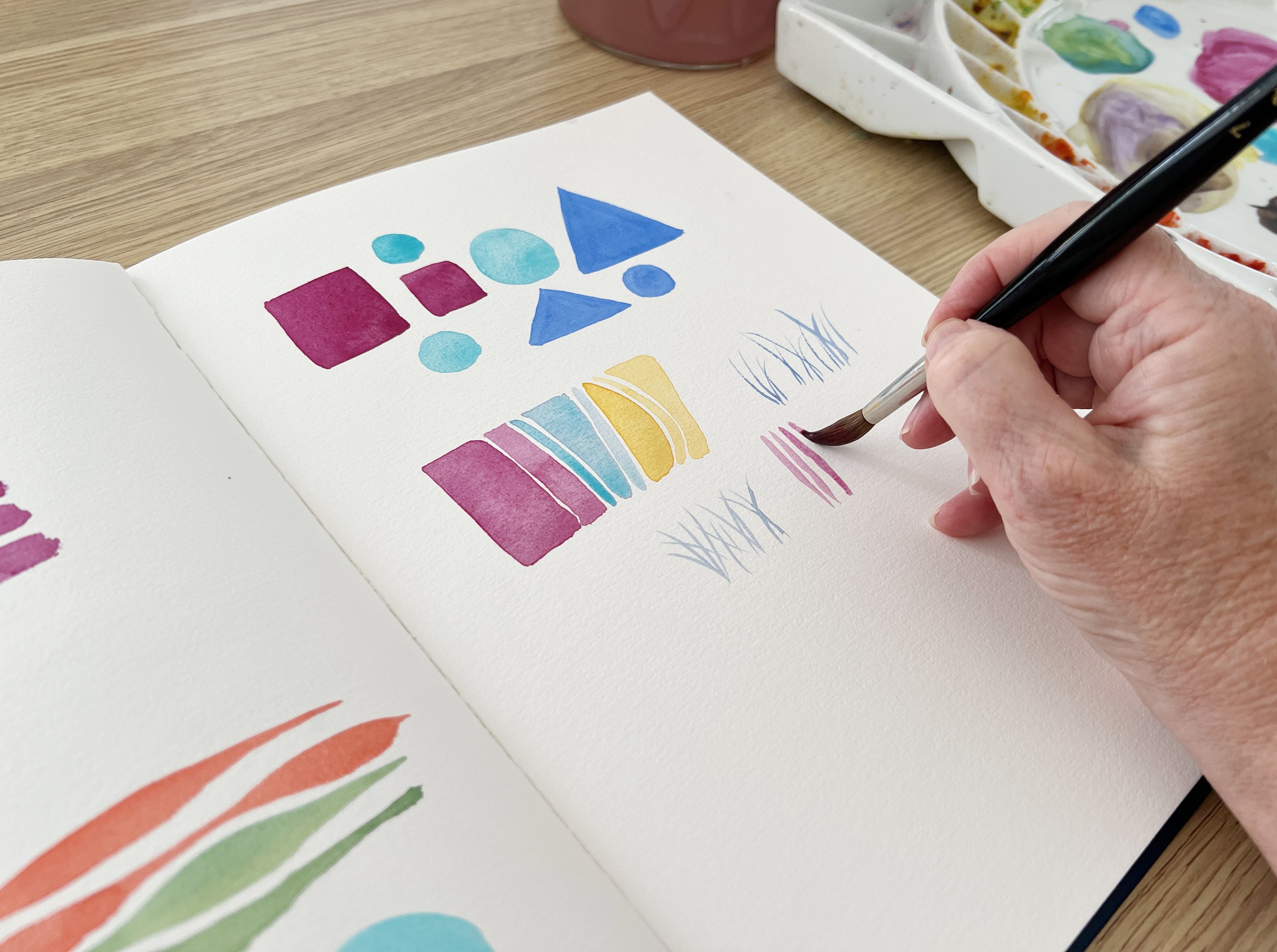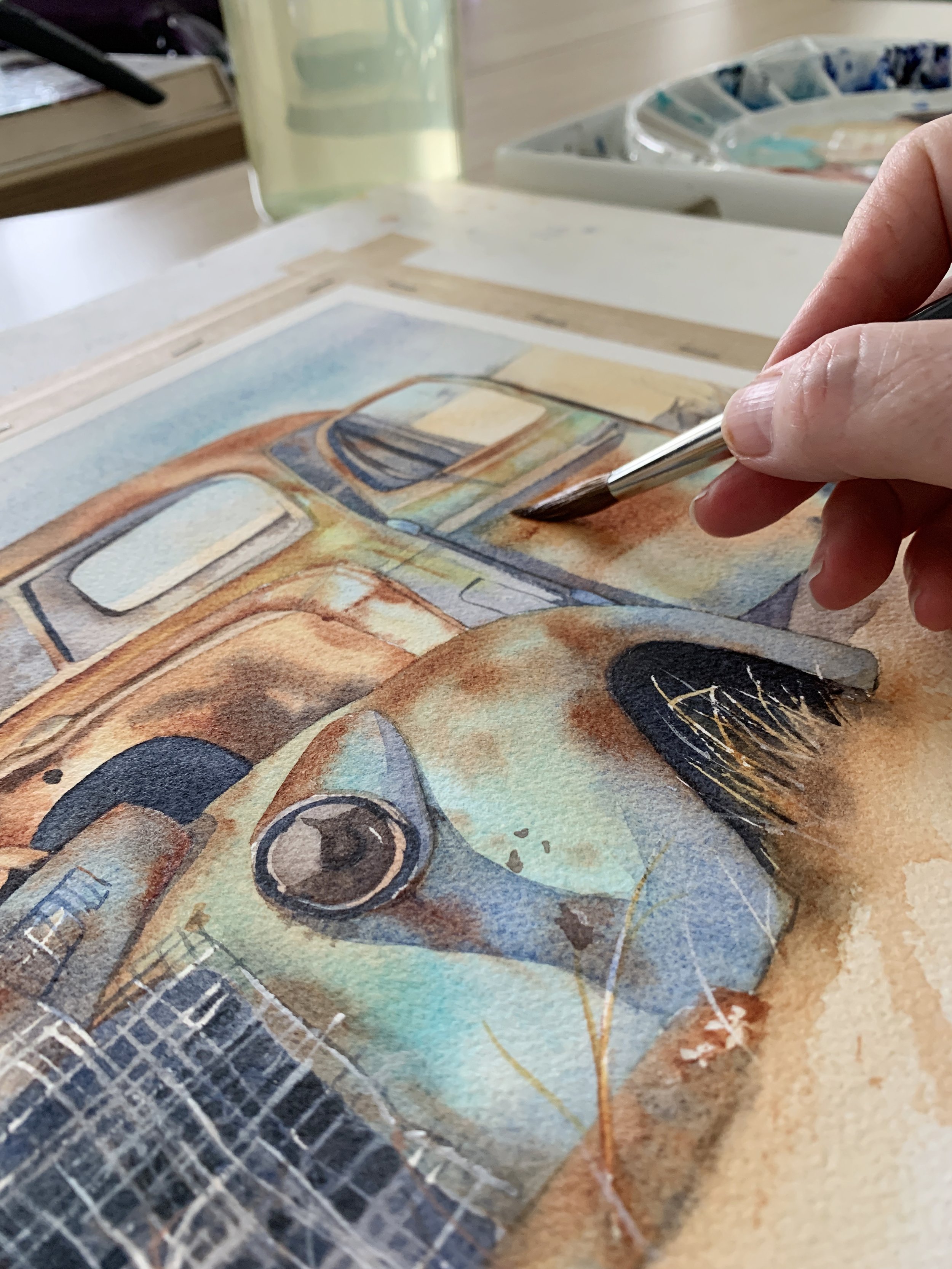Many beginners find colour wheels confusing and not very intuitive. Instead, I recommend a more straightforward approach and easy trick: utilising the online resources of reputable paint manufacturers like Winsor and Newton, Daniel Smith, or Schmincke. These companies organise their colours not just by hue but by temperature, which can be immensely helpful.
Read MoreColour value, in its essence, refers to the lightness or darkness of a colour. In watercolour painting, where the medium's transparency plays a crucial role, value becomes a powerful tool. It's not just about choosing the right colours but understanding their inherent lightness or darkness and how they interact on paper. This interaction is what ultimately shapes the mood, depth, and realism of our work.
Read MoreIn my studio, surrounded by brushes, pigments, painting materials and light that inspires my work, the choice of paper is paramount. The watercolour paper surface and the used sizing will greatly affect the outcome. I've found that artist-quality papers, like Arches, offer a balance that complements the lifting technique beautifully.
Read MoreBefore you start painting, every artist’s journey begins with the first step: selecting your tools and getting familiar with all the materials you need. Watercolour paints come in pans and tubes, each with its unique charm. Watercolour brushes, in their myriad shapes and sizes, are your loyal companions, and watercolour paper—your canvas—awaits with its textures and weights. There is cold press paper, hot press paper, paper, that lies in between... Let's not forget the supporting cast: watercolour palette, masking fluid, and sponges.
Read MoreImagine water as the dance partner in your watercolour tango. Like any good partner, water can lead you to create fluid, dynamic movements on the paper. However, if not in sync, it can step on your toes, causing washes to bleed uncontrollably or colours to become dull. Very little water will result in dry brush like strokes, whereas too much water will flood your paper and make the colour hard to handle.
Read MoreWorking as a full-time artist leaves me with hardly any time for other activities, which is why my rose garden has become a jungle of weeds 😬. The few roses that survive are struggling to find space to breathe among all the overgrowth. Despite this, my 'Heaven Scent' rose miraculously managed to produce this little gem.
I cut it free from the weeds that were smothering it and left it in a vase to open slightly before I painted it.
Read MoreSynthetic brushes are not only good for watercolour painting; they are an excellent choice for many artists. Their durability, versatility, and ethical production make them suitable for a wide range of watercolour techniques, from broad washes to fine details.
Whether you’re a beginner looking for a cost-effective way to start painting or a professional seeking reliable tools, synthetic brushes offer quality and performance that can meet—and even exceed—your painting needs.
Read MoreOne thing most watercolour artists try to avoid is making mud when they mix colours.
Muddy colours appear lifeless or lacking in vibrancy. To avoid making dull colours it's best to use transparent colours when you mix paint.
Opaque pigments, because they are heavier and denser, tend to become dull and lifeless when you mix with them, particularly when you mix two or more opaque pigments together. If you need to mix with an opaque pigment - pair it with a transparent pigment to avoid a thick and heavy mixture.
Read MoreBackgrounds in art fill the critical space between the subject and the frame, turning empty canvases into resonant scenes brimming with life. They define the positive (subject) and negative (space around the subject) spaces, adding layers of depth and context. A background can support the main subject with a contrasting or complementary backdrop or even steal the spotlight, as Vincent van Gogh’s “Starry Night” beautifully illustrates. They're not just settings; they're expressions, setting the mood, suggesting settings, and influencing the viewer's emotional response.
Read MoreDiving into the world of watercolor painting can be both exhilarating and a bit daunting for beginners. With its beautiful washes and vibrant hues, watercolor art offers a unique medium to express creativity. However, the thought of mastering this fluid form of painting might seem overwhelming at first.
Read MoreUnstretched paper naturally buckles when water and wet paint are applied, as the paper's fibres expand, creating an uneven surface that presents challenges during painting. This buckling can result in unexpected streaks, blooms, and undesirable edges, ultimately compromising the intended effect of the artwork. As well as that, the buckled paper may dry unevenly, which not only effects the painting process but also the presentation of the finished painting. Techniques like wet-on-wet or gradients, which rely on precise control over the paper's moisture, become difficult to execute effectively when the paper is not properly flattened.
Read MoreBefore diving into specific colour substitutions, it's crucial to understand colour properties: hue, value, and saturation. These are universal, regardless of the brand. Hue refers to the colour itself, value to its lightness or darkness, and saturation to its intensity. When looking for a substitute, aim for a match in these three properties, and you'll be close to the original colour.
Read MoreSynthetic brushes are made from synthetic fibres such as nylon, Taklon, or a blend of synthetic materials. They are vegan and cruelty-free, appealing to those who prefer not to use brushes made from natural hair. They may not hold water as well as natural hair brushes but with advancements in brush technology, synthetic brushes now have improved water retention. They are generally more affordable than natural hair brushes, so if you are a beginner or you are on a budget, synthetic brushes are a good choice.
Read MoreBefore you start practicing there are several factors that can affect the outcome and quality of your brush strokes in watercolour painting.
Be aware of how much water you have mixed into your paint mixture. Thicker paint may result in more textured strokes, while thinner paint creates smoother, more translucent effects. When you are practicing brush strokes like those demonstrated in this blog post, you want the paint brush to glide over the paper so your paint mixture needs to be fluid and not too thick.
Read MoreUnderstanding the amount of water on your brush and its interplay with the paper is vital. Watercolour techniques like dry-on-dry, wet-on-dry, wet-on-wet, and dry-on-wet are not just techniques; they are the essence of watercolour painting. Each watercolour method allows for a different expression of water and pigment, and mastering these can elevate your art.
Many beginners may not use enough water on their paper. The brush should glide effortlessly over the paper for most techniques, except for dry brushing. Adjusting the water level in the paint mixture or in your brush, can help achieve the right flow.
Read MoreOpacity is influenced by the degree of dilution in watercolour paints. Water is used for diluting watercolour paint, and the extent of dilution directly impacts the tonal value of the paint colour. It's worth noting that transparent pigments, when applied to the paper at their full intensity (with minimal water added), can appear opaque. On the other hand, when water is used to thin down opaque pigments, they can show a more transparent quality.
Read MoreThe pre-mixed blacks appear a bit dull and uninspiring compared to the black I mixed myself. There's just something about the personally mixed hue that adds a touch of life to it. It's subtle, but it makes a difference.
When you mix blacks you can also adjust the temperature of the colour which will add some life to your paintings. Because you are mixing colours together, you are in control of the ratios. If you want a cool black, mix more of the cool colour you are using. If you want a warm black use a bit more of the warm colour you are mixing with.
Read MoreThe goal of using a limited palette is to achieve color harmony, simplify the decision-making process, and gain better control over the interaction of colors in a painting. You use a limited palette to create balanced, cohesive, and visually pleasing paintings.
It's important to note that a limited palette is not 'limiting'. Hazel Soan emphasises that working with a limited palette doesn't confine your creativity; instead, it sets you free. It empowers you to paint fearlessly, secure in the knowledge that your colors will harmonise effortlessly.
Read More
















